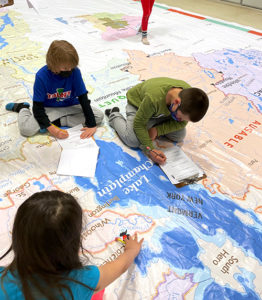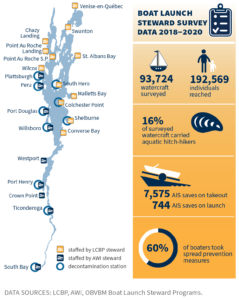School programs are educating young learners about watershed issues, providing a foundation for informed decisions about the Lake’s challenges.

Providing students an understanding of watershed science and natural and cultural resources at an early age is critical in fostering the next generation of stewards. Classroom and field-based learning centered on rich watershed content helps students make informed choices about their personal actions. This information is also often extended to family and friends when students share their knowledge and values at home.
Watershed education begins with teacher training. Recent professional development programs offered by Basin partners have included graduate-level coursework and focused place-based trainings that cover topics such as green infrastructure, phytoplankton, the Underground Railroad, and geology. The new knowledge that teachers have taken from these trainings to their classrooms is publicly displayed during the Champlain Basin Education Initiative’s local celebration of the U.N. World Water Day. Since 2018, the event has showcased exemplary student work—often based on their teachers’ own learning—from 34 classrooms representing 21 schools in the Basin.
Several new programs have brought watershed learning directly to students. In 2020, the Lake Champlain Sea Grant’s Watershed Alliance program expanded from the University of Vermont to SUNY Plattsburgh, allowing 450 New York students to participate in lake and stream ecology programs. This and similar field programs offered by Paul Smith’s College, Miner Institute, Lake George Association, and Trout Unlimited reached more than 4,000 students each year.
The COVID-19 pandemic has had the most evident and perhaps the greatest long-term effect on watershed education. The pandemic required a rapid retooling of traditional school outreach programs into virtual offerings. Interactive learning events, opportunities for students to meet scientists, and cultural heritage interpretation that are available to broad audiences and classrooms unable to travel are likely to continue in some form after the pandemic.
Public outreach programs and efforts to track their effectiveness are helping to inform all citizens about watershed issues.
Even during the COVID-19 pandemic, community members have had a variety of opportunities to participate in new science-based field trips, naturalist-led recreation opportunities, and history tours. This public programming is at the heart of local watershed organizations’ work. The outings they lead provide hands-on learning about a range of topics, from redesigning residential driveways in order to slow runoff to diversifying habitat by planting native vegetation.
Tracking changes in personal behaviors that result from these programs can be challenging, but many partners have begun to focus on assessing the effectiveness of education and outreach efforts. Local organizations as well as larger programs and institutions are conducting program-specific evaluations and longer-term surveys to gauge success and guide future efforts.
In one such evaluation, Lake Champlain Sea Grant surveyed participants in an educational boating excursion. They found that one year after the outing, 51% of respondents said they avoided purchasing plastics, 31% said they left grass clippings on their lawn to increase water infiltration, and 65% said they shared the knowledge they learned with others.
The LCBP is working with partners to conduct a Basin-wide survey that measures stakeholder knowledge of watershed issues and levels of engagement and stewardship by residents. The results of the survey will help to track the effectiveness of outreach efforts and to shape future public programming offered by partners.
The boat launch steward program on Lake Champlain continues to be an important element of public outreach. Stewards inspect boats for hitchhiking aquatic invasive species and provide information to the public about preventing the spread of these species. The Adirondack Watershed Institute (AWI) of Paul Smith’s College, the Lake George Association, the LCBP, and numerous lake associations monitor launches.
LCBP and AWI staff reached nearly 193,000 people at launch sites on Lake Champlain from 2018–2020 (Figure 22). About 16% of vessels inspected during this time period carried aquatic species, and half of those carried invasive species. Stewards greeted about 30% more users at the monitored launch sites, and greeters at inland lakes saw increases of users of 25% or more in 2020.

These groups collaborate on data collection and analysis and on staff training to ensure that boaters receive consistent information across the region. The programs have refined their techniques for surveying boater behavior and have found that 60% of 93,724 boat owners surveyed took measures to prevent the spread of aquatic invasive species. This metric will be useful going forward for monitoring the effectiveness of outreach efforts.
The LCBP’s Resource Room at ECHO, Leahy Center for Lake Champlain in Burlington, Vermont, hosted over 30,000 visitors annually in 2018 and 2019, cultivating stewardship through personal action and community partnerships. Staff encouraged guests to explore watersheds near their homes and provided information about local conservation organizations. Resource Room staff shared interpretive materials about Lake Champlain, presented programs, and provided place-based educational resources to visitors. The Resource Room remained open during much of the COVID-19 pandemic, adding new cultural heritage resources, creating a more diverse library for guests, and fielding questions virtually.


